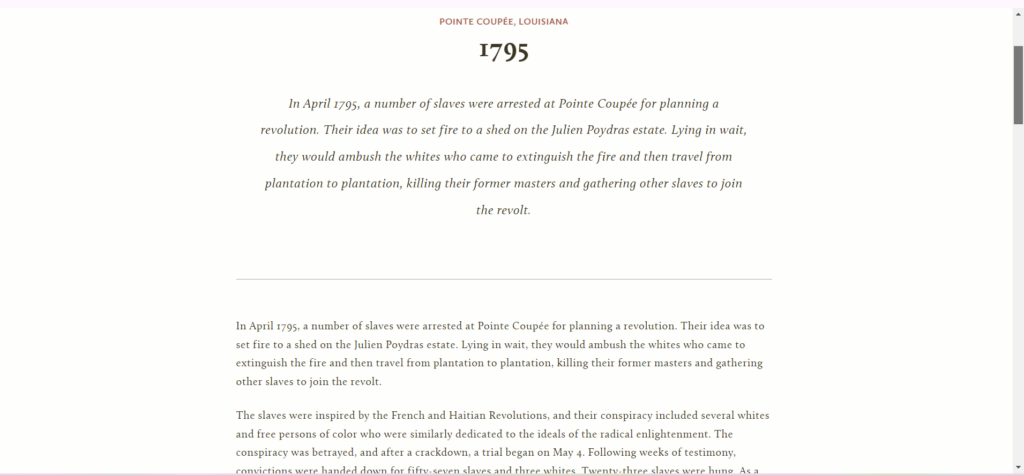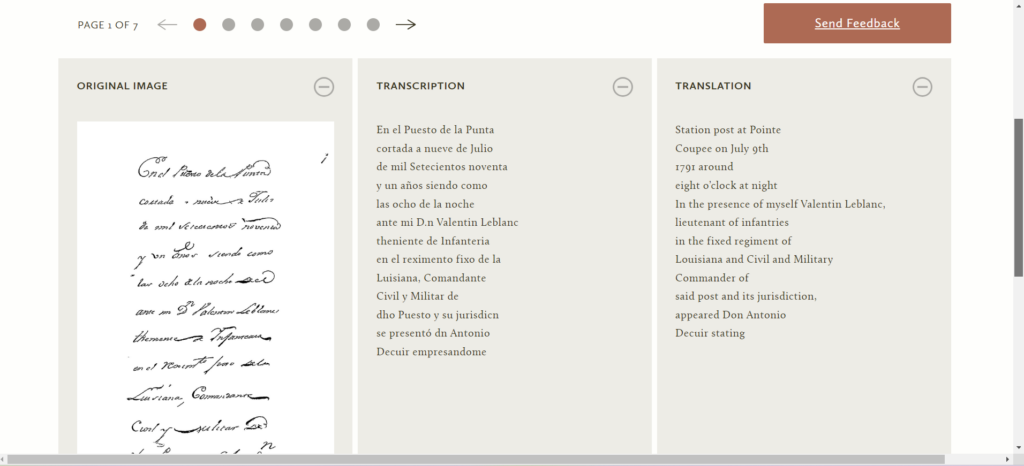From a user’s perspective, a website’s most crucial elements revolve around a seamless and enjoyable experience. The first encounter with a site is greatly influenced by its loading speed, with users expecting quick access to information. With smartphones and mobile devices being so prevalent, having a mobile friendly site is crucial. Clear and intuitive navigation is paramount, as users should easily find their way around the site without frustration. The call-to-action buttons play an important part in this. Having the ease of access with these buttons allows users to easily navigate the different aspects of a site. Collectively, these elements contribute to a positive user experience, fostering satisfaction and encouraging continued exploration of the website’s offerings. Berkeley’s website on Louisiana Slave Conspiracies includes many of these aspects.
The central theme of this website revolves around delving into the intricate details of two historical slave conspiracies that transpired in Louisiana during the years 1791 and 1795. Upon initially navigating to the site, visitors encounter a visually divided homepage. The first half of the page features a map showcasing the geography of the Mississippi River and Fausse Riviere, adorned with what appears to be names inscribed along the riverbanks. This visual representation aims to provide users with a spatial context for the historical events under discussion.

On the other half of the homepage, the website’s true essence unfolds. Positioned beneath the header are prominently displayed call-to-action buttons labeled: Home, Documents, People, Places, Research, and About. This strategic organization enables users to efficiently navigate the site and explore specific aspects of the historical narratives that pique their interest.
Further down the page, a succinct overview of the 1795 slave conspiracy is presented, accompanied by an enticing call-to-action button labeled “Overview.” Clicking on this button leads users to an expansive article that comprehensively covers the details of the 1795 slave conspiracy. Despite this informative content, the homepage’s initial impression might be perceived as somewhat cryptic, as it does not immediately provide extensive information.


Similarly to the initial homepage, there is a map showcasing the False River with what appears to also be names inscribed along the riverbank. The map, while visually engaging, lacks an immediate explanatory context, leaving users desiring more insight into the significance of the names inscribed along the rivers. As users explore the homepage, the final component is a call-to-action button labeled “1791.” Clicking on this button redirects users to a dedicated page akin to the homepage, specifically focused on unraveling the details of the 1791 slave conspiracy.
In summary, the homepage serves as a gateway to a wealth of historical information, with its divided layout offering a balance between visual appeal and organized navigation. The call-to-action buttons guide users to specific areas of interest, while the map and brief synopses provide tantalizing glimpses into the historical events without immediately revealing the full depth of the content, encouraging exploration and deeper engagement.
As we delve deeper into the intricacies of the site, its primary function becomes apparent: it serves as a comprehensive archive and database. Starting with the first call-to-action button labeled “Documents,” the user is lead to a section of the site that offers a profound exploration of the subject matter. This segment presents an extensive catalogue of documents related to both slave conspiracies, marking the inception of a more immersive experience.

This section introduces a notable enhancement in functionality, featuring a search bar and the option to filter documents based on specific criteria. The user-friendly design facilitates seamless navigation, allowing users to sift through documents related to the 1791 and 1795 slave conspiracies based on various parameters, including the relevant year, the respondent’s identity, references to slaves or enslavers, legal status, and language.

Upon clicking the link to access these documents, an abundance of information unfolds. The initial view showcases the original document, complete with a photograph of the handwritten script, followed by a transcription and translation for each page. This meticulous presentation is accompanied by a convenient call-to-action button that allows a page-by-page exploration.
While the ability to view the authentic document is invaluable, the transcendent utility lies in the transcription and translation services. Given that many of these historical documents were composed in either French or Spanish using ink and quill, deciphering them proves challenging. The inclusion of translations empowers readers, irrespective of their proficiency in these languages, to grasp the essence of the written content.
Following the document exploration, the user is presented with yet another call-to-action button labeled “Information.” This link navigates to a dedicated page offering a more profound understanding of the document. The provided information encompasses details such as the conspiracy it is associated with, document type, location, date, language, individuals involved, and the archival context. At the bottom of the page, an interactive map with a pinpoint illuminates the geographical location along the Mississippi River where the document originated.
In conclusion, the archive of documents not only boasts ease of navigation but also delivers a rich and user-friendly experience. The meticulous organization, coupled with the incorporation of transcription, translation, and supplementary information, elevates the user’s exploration of historical documents related to the slave conspiracies of 1791 and 1795.
Moving on to the next call-to-action button, labeled “People,” users are directed to a page akin to the preceding documents section. This area features a user-friendly interface equipped with a search bar and various filtering options, allowing users to refine results based on criteria such as name, gender, race, age, occupation, location of residence, and sentence. Even without employing the search or filter functions, the page hosts an extensive database of names associated with the slave conspiracies.

Upon selecting a name from the database, users are redirected to a page offering fundamental details about the individual. For enslaved individuals, the information encompasses details related to the conspiracy they were involved in, their gender, race, enslaver, residence, legal record, and any additional known information. For non-enslaved individuals, the page provides similar information, including the individual’s occupation. This streamlined approach ensures that users seeking specific individuals can easily access comprehensive information about the person in question.
The efficiency of this people database is further underscored by its simplicity, enabling users to navigate through specific names and access detailed information effortlessly. Additionally, the system facilitates the filtering of individuals associated with their respective conspiracies or other specified criteria, thereby enhancing the user’s ability to refine their exploration according to their specific interests.
The last call-to-action button of importance is labeled “Places.” Here, the user is greeted by an interactive map and a few filtering options. The options to filter are based on location name, related conspiracy, and type of location. Without filtering anything, the interactive map includes pinpoints of all relative and important locations related to the 1791 and 1795 conspiracies. By clicking one of these pinpoints, a call-to-action button pops up directing the user to a page that provide some more in-depth information on that location. Some of this information includes the type of location, the owner or settlement the location belongs, the respective conspiracy, and any people associated with that location. This compilation of places provides easy access to information about these locations.


There is, however, one part of this section of the site that is not so apparent. Below the interactive map there is a call-to-action button labeled “about the map.” Without knowing it is a call-to-action button, it can be easily overlooked. This button brings the user to a page that explains how the locations were identified and pinpointed on the map.

The last two buttons, while still important, may not be very useful to users attempting to find specific information quickly. These buttons are labeled “Research” and “About.” The research button brings the user to the bibliography and sources used for the mapping. The about button includes all of the people associated with compiling information and designing the website.
In conclusion, Berkeley’s website on Louisiana Slave Conspiracies provides users with a comprehensive and accessible platform. The site’s design emphasizes a seamless and enjoyable user experience, and caters to mobile users, ensuring broad accessibility.
The archive of historical documents stands out as a highlight, offering a user-friendly interface with search and filter functionalities. The inclusion of transcriptions and translations for documents in French or Spanish enhances accessibility, enabling a broader audience to understand the content. The “People” section further contributes to the site’s comprehensiveness, allowing users to easily navigate through names associated with the slave conspiracies, with detailed information provided for both enslaved and non-enslaved individuals. The “Places” section, although informative, could benefit from making the “About the Map” button more prominent for a clearer understanding of the mapping process. Overall, the website succeeds in delivering a rich and user-friendly experience, allowing individuals to explore historical events, documents, and associated figures with ease. The meticulous organization, coupled with the inclusion of supplementary information, contributes to the site’s overall effectiveness and encourages continued exploration.


Leave a Reply